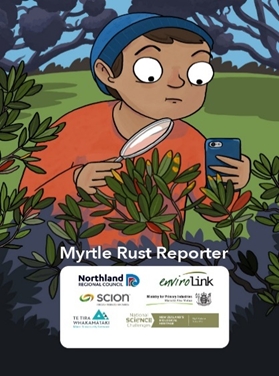PESTS AND DISEASES OF FORESTRY IN NEW ZEALAND
Myrtle rust reporter
Scion is the leading provider of forest-related knowledge in New Zealand
Formerly known as the Forest Research Institute, Scion has been a leader in research relating to forest health for over 50 years. The Rotorua-based Crown Research Institute continues to provide science that will protect all forests from damage caused by insect pests, pathogens and weeds. The information presented below arises from these research activities.
From Forest Health News 278, January 2018.
Myrtle rust is a serious biosecurity threat that affects a number of New Zealand’s native plants, including pohutukawa, ramarama, northern and southern rata and manuka. We need your help to protect our natural and productive environments. As citizen scientists one way to help is by finding and mapping potential host plants, and then monitoring them periodically for signs of the disease.
 The Myrtle Rust Reporter is a new tool in our fight against this disease, brought to you by Northland Regional Council, Scion, Envirolink, Te Tira Whakamataki (Maori Biosecurity Network), Biological Heritage National Science Challenge, and the Ministry for Primary Industries (MPI).
The Myrtle Rust Reporter is a new tool in our fight against this disease, brought to you by Northland Regional Council, Scion, Envirolink, Te Tira Whakamataki (Maori Biosecurity Network), Biological Heritage National Science Challenge, and the Ministry for Primary Industries (MPI).
The Myrtle Rust Reporter app is freely available in the iPhone and Android app stores by searching for ‘myrtle rust reporter’. We encourage you to give this new bilingual app a go and use it to record a dozen potential host plants in your community. You will become the caretakers of these specific plants. Check these plants regularly and look for telltale yellow spores on the new growth (some excellent examples are found inside the app). If you think you’ve found myrtle rust, remember not to touch the plant or the symptoms. Take a picture, submit your record using the app and then immediately phone MPI on 0800 80 99 66. The biosecurity respo nse officer on the phone will use your app username to look up your record and discuss the photo you have submitted.
The app works with NatureWatch NZ so that all New Zealanders have the tools to participate in the myrtle rust surveillance campaign. The connection of the app with the NatureWatch NZ community links you with other interested naturalists and experts that can give you a hand to identify plants to ensure you are monitoring potentially susceptible plants from the myrtle family. Suspect records of potential myrtle rust infections are reported to MPI that feedback response outcomes to users via the myrtle rust reporter project on NaturewatchNZ (http://naturewatch.org.nz/projects/myrtle-rust-reporter)
It is critical that you do record your host plants so that we all know which plants you are looking after. Myrtle ru st has so far been found in Northland, Auckland, Waikato, Taranaki, Te Puke, and Wellington, however New Zealand is a big place and myrtle rust has microscopic spores so as a group we need to make sure we cover as much of New Zealand as possible.
Steve Pawson (Scion)
This information is intended for general interest only. It is not intended to be a substitute for specific specialist advice on any matter and should not be relied on for that purpose. Scion will not be liable for any direct, indirect, incidental, special, consequential or exemplary damages, loss of profits, or any other intangible losses that result from using the information provided on this site.
(Scion is the trading name of the New Zealand Forest Research Institute Limited.)

 Farm Forestry New Zealand
Farm Forestry New Zealand

